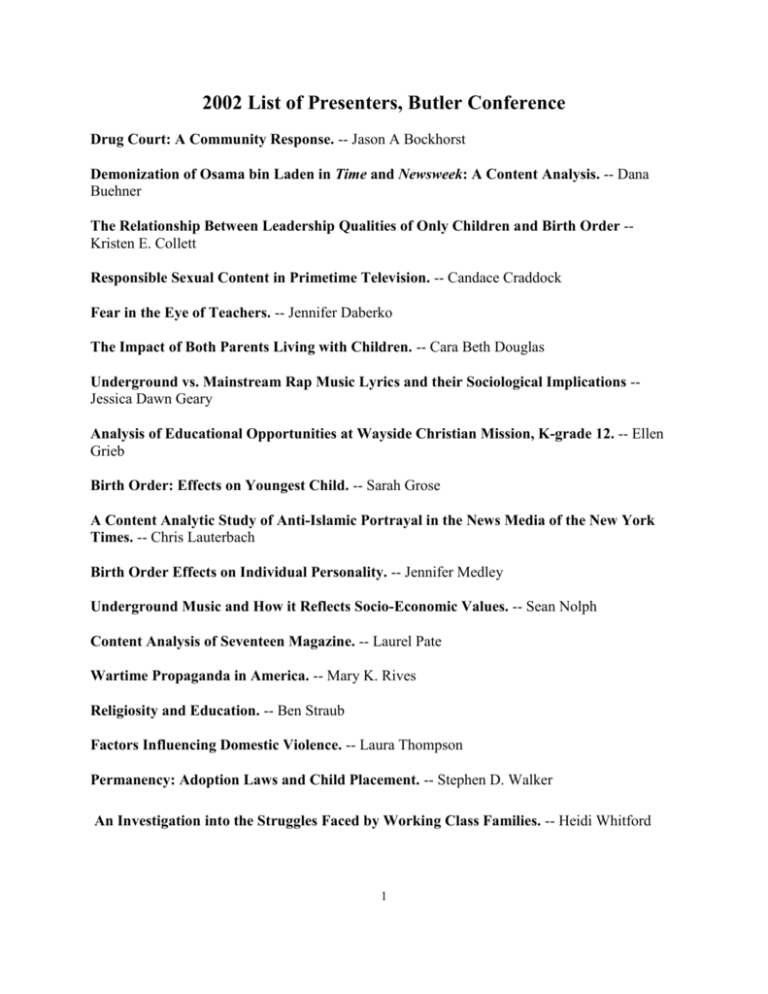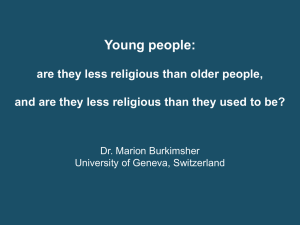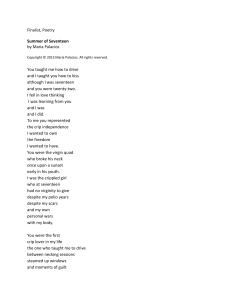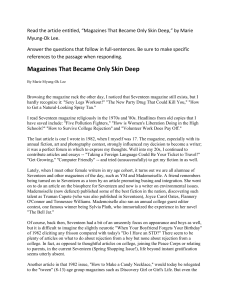The Relationship Between Leadership Qualities of Only Children
advertisement

2002 List of Presenters, Butler Conference Drug Court: A Community Response. -- Jason A Bockhorst Demonization of Osama bin Laden in Time and Newsweek: A Content Analysis. -- Dana Buehner The Relationship Between Leadership Qualities of Only Children and Birth Order -Kristen E. Collett Responsible Sexual Content in Primetime Television. -- Candace Craddock Fear in the Eye of Teachers. -- Jennifer Daberko The Impact of Both Parents Living with Children. -- Cara Beth Douglas Underground vs. Mainstream Rap Music Lyrics and their Sociological Implications -Jessica Dawn Geary Analysis of Educational Opportunities at Wayside Christian Mission, K-grade 12. -- Ellen Grieb Birth Order: Effects on Youngest Child. -- Sarah Grose A Content Analytic Study of Anti-Islamic Portrayal in the News Media of the New York Times. -- Chris Lauterbach Birth Order Effects on Individual Personality. -- Jennifer Medley Underground Music and How it Reflects Socio-Economic Values. -- Sean Nolph Content Analysis of Seventeen Magazine. -- Laurel Pate Wartime Propaganda in America. -- Mary K. Rives Religiosity and Education. -- Ben Straub Factors Influencing Domestic Violence. -- Laura Thompson Permanency: Adoption Laws and Child Placement. -- Stephen D. Walker An Investigation into the Struggles Faced by Working Class Families. -- Heidi Whitford 1 Selected Abstracts from the Butler Conference The Relationship Between Leadership Qualities of Only Children and Birth Order Kristen Collett For years, only children in the United States have been described as self-centered, unhappy, attention seeking, and unlikable. However, a variety of experimental studies have concluded that only children are better leaders than children with siblings. In order to explore the leadership of only children, a purposive sample of 20-30 only children, ages 18 and older, was recruited from a medium-sized, mid-western American city. These only children were given an 18-question survey and asked to participate in an in-depth interview. A constant comparative technique was used to compile the most frequent answers given by the subjects. This study focuses on the leadership qualities of only children by exploring whether or not a sample of only children exhibit seven characteristics that are representative of leadership. Research will also explore if these children possess these qualities as a result of birth order or because of a variety of independent reasons, such a parenting style, education, and environment. Religiosity and Education Ben Straub The purpose of this research is to find if there appears to be any correlation between a person’s religiosity and the level of formal education they have obtained. The theory that this research hopes to test states those people who have achieved a high level of education are most likely to have a lower level of religious belief, and visa versa. This theory stems from the belief that as a person continues on into higher levels of education, they will be exposed to natural sciences, whose claims often differ from the claims of most religions. This research will consist of a study of secondary data obtained from the General Social Survey website. The data will mainly focus on variables dealing with topics such as one’s religious beliefs, and the level of education the respondent has obtained. Content Analysis of Seventeen Magazine Laurel Pate Previous research using content analysis has shown teen magazines construct a world in which young women must attempt to discern the minds and desires of young men in order to attract them. These magazines present a treacherous and insolvent series of orders for female teens to learn the wonders of the world from. Their emphasis is on the centrality of heterosexual relationships and the need to achieve stereotypical norms of physical attractiveness through the consumption of products such as cosmetics, fashionable clothing, and diet aids (Durham, 1998.) Present research used covers of Seventeen magazine to determine the sexual content of its messages and to exam how these messages have changed historically. The sample included 100 issues from the years 1976-2001. 2




![Some Qualities of a Good Teacher[1]](http://s2.studylib.net/store/data/005352484_1-a7f75ec59d045ce4c166834a8805ba83-300x300.png)






